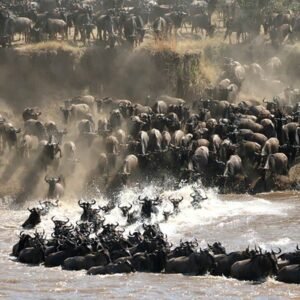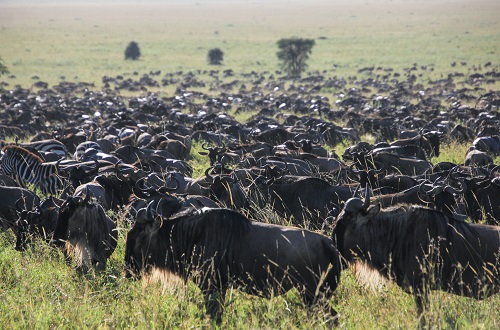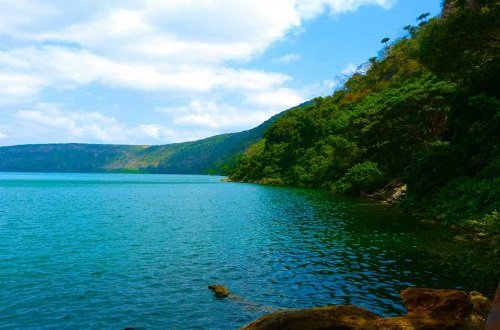Serengeti National Park is a renowned and vast wildlife reserve located in the northwestern part of Tanzania, East Africa. It is one of the most iconic and diverse national parks in the world, covering an area of approximately 14,763 km2 (5,700 square miles). Established in 1951, Serengeti National Park is a UNESCO World Heritage Site and also forms a part of the larger Serengeti ecosystem, which includes several other protected areas and reserves.
The greatest wildlife destination on earth
The magic of Serengeti National Park is not easy to describe in words. Not only seeing, but also hearing the buzz of millions of wildebeest so thick in the air that it vibrates through your entire body is something you will try to describe to friends and family, before realising it’s impossible. Vistas of honey-lit plains at sunset so beautiful, it’s worth the trip just to witness this. The genuine smiles of the Maasai people, giving you an immediate warming glow inside. Or just the feeling of constantly being amongst thousands of animals – it doesn’t matter what season of the migration you visit the Serengeti National Park, it’s magical all year round.
The never-ending circle of the Great Migration
Serengeti National Park was one of the first sites listed as a World Heritage Site when United Nations delegates met in Stockholm in 1981. Already by the late 1950s, this area had been recognised as a unique ecosystem, providing us with many insights into how the natural world functions and showing us how dynamic ecosystems really are.
Today, most visitors come here with one aim alone: to witness millions of wildebeest, zebras, gazelles and elands on a mass trek to quench their thirst for water and eat fresh grass. During this great cyclical movement, these ungulates move around the ecosystem in a seasonal pattern, defined by rainfall and grass nutrients. These large herds of animals on the move can’t be witnessed anywhere else. Whereas other famous wildlife parks are fenced, the Serengeti is protected, but unfenced. Giving animals enough space to make their return journey, one that they’ve been doing for millions of years. Read more about the Great Migration.

Beyond the Great Migration
Even though, for many travellers, the migration is one of the main reasons to visit Serengeti National Park, it’s worth looking beyond this immense spectacle. First of all, nature can’t be directed. Having realistic expectations of your chances to witness a river crossing, or a large herd on the move, is crucial. A river crossing for example often only lasts thirty minutes, so can be missed in the blink of an eye. But don’t let this discourage you: there are plenty of other reasons to visit the Serengeti.
If it’s not for this vast stretch of land where you can drive forever and never get enough, it might be for the incredible skies of dazzling colours, or the primal feeling of excitement when a deep dark-grey thunderstorm appears on the broad horizon.
Or you might answer the lion’s call, and come to the Serengeti for one of the largest concentrations of predators in the world: the herds support about 7,500 hyenas, 3,000 lions and 250 cheetahs. And how about the silent grey giants? Elephants in the Serengeti amble over the plains into the woodlands, feasting on leaves and tree branches. Read more about wildlife in Serengeti wildlife.
Tribes in the cradle of human life
Even though animals still rule the plains of the Serengeti, this area has an incredibly long history of human occupation. Not only humans, but also human ancestors (Australopithecus afarensi) lived in this area for almost 4 million years. Today, Serengeti National Park is still home to several indigenous tribes. One of the most famous tribes is the Maasai: this tribe is unique and popular due to their long-preserved culture. Despite education, civilization and western cultural influences, the Maasai people have clung to their traditional way of life, making them a symbol of Tanzanian and Kenyan culture. Read more about the Maasai people.
Vibrancy, variety and vastness
You will soon realise that amazement doesn’t have boundaries in this world-renowned National Park of Tanzania. Serengeti is a transition area, with distinct changeovers going from rich flat soils, to poor hilly soils in the north, attracting a wide variety of vegetation and animals. Whether you are looking for big cats, birds or even smaller creatures: Serengeti National Park delivers. Even to understand and experience just a small part of this ecosystem, will change your vision on our world and the environment.
After being overwhelmed by the vibrancy, variety and vastness of this land, this place of transition will leave you changed forever.
History of Serengeti National Park
In the late 1800s and early 1900s, explorers and missionaries described the Serengeti plains and the massive numbers of animals found there. Only minor details are all that were reported before explorations in the late 1920s and early 1930s supply the first references to the great wildebeest migrations, and the first photographs of the region.
An area of 2,286 square kilometers was established in 1930 as a game reserve in what is now southern and eastern Serengeti. They allowed sport hunting activities until 1937, after which it stopped all hunting activities. In 1940 Protected Area Status was conferred to the area and the National Park itself was established in 1951, then covering southern Serengeti and the Ngorongoro highlands. They based the park headquarters on the rim of Ngorongoro crater.
So, the original Serengeti National Park, as it was gazetted in 1951, also included what now is the Ngorongoro Conservation Area (NCA). In 1959, the Ngorongoro Conservation Area was split off from the Serengeti National Park and they extended the boundaries of the park to the Kenya border. The key reason for splitting off the Ngorongoro area was that local Maasai residents realized that they were threatened with eviction and consequently not allow to graze their cattle within the national park boundaries. To counter this from happening, protests were staged. A compromise was reached wherein the Ngorongoro Crater Area was split off from the national park: the Maasai may live and graze their cattle in the Ngorongoro Crater area but not within Serengeti National Park boundaries.
In 1961 the Masai Mara National Reserve in Kenya was established and in 1965 the Lamai Wedge between the Mara River and Kenya border was added to Serengeti National Park, thus creating a permanent corridor allowing the wildebeests to migrate from the Serengeti plains in the south to the Loita Plains in the north. The Maswa Game Reserve was established in 1962 and a small area north of The Grumeti River in the western corridor was added in 1967.
The Serengeti National Park was among the first places to be proposed as a World Heritage Site by UNESCO at 1972 Stockholm conference. It was formally established in 1981.
Best time to visit Serengeti National Park in Tanzania
The best time to visit Serengeti National Park is during the dry season, from late June to October, which offers excellent game viewing opportunities as animals gather around waterholes and the grass is shorter, providing clearer views. The wildebeest migration typically occurs from December to September, with specific locations varying depending on the time of year.
Best Tanzanian Serengeti National Park activities
1. Game Drives
Game drives are the most popular activity in Serengeti National Park. Guided tours in 4×4 vehicles offer visitors the chance to explore the vast landscapes and encounter a diverse array of wildlife.
2. Balloon Safaris
Hot air balloon safaris provide a unique and breathtaking perspective of the Serengeti’s landscapes and wildlife from the sky.
3. Birdwatching
With its rich birdlife, the Serengeti provides excellent opportunities for birdwatchers to spot and identify various avian species.
Best Serengeti’s key features and landscape
1. Savannah Plains
The Serengeti is characterized by its sweeping savannah grasslands that extend as far as the eye can see. These grasslands provide a fertile habitat for an abundance of wildlife.
2. Great Wildebeest Migration
One of the park’s most spectacular events is the annual wildebeest migration. Every year, over a million wildebeest, along with hundreds of thousands of zebras and other antelope species, embark on a circular journey across the Serengeti plains in search of greener pastures. This phenomenon is considered one of the most remarkable wildlife spectacles on the planet.
3. Wildlife
The park is home to the famous African “Big Five”: lions, elephants, buffaloes, leopards, and rhinoceroses. Additionally, it boasts an impressive diversity of other wildlife, including cheetahs, giraffes, hippos, crocodiles, hyenas, and various species of antelope.

4. Birdlife
Serengeti National Park is a haven for birdwatchers, with over 500 species of birds recorded. These include ostriches, vultures, eagles, storks, and flamingos, among others.
5. Birdlife
The park features unique rock outcrops called kopjes, which serve as excellent vantage points for predators such as lions and leopards. They also provide shelter and nesting sites for various bird species.
6. Rivers and Waterholes
Several rivers and permanent waterholes throughout the park sustain wildlife year-round, attracting a concentration of animals and providing opportunities for visitors to observe them up close.



